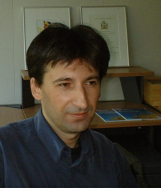New tools for nanotechnology: from single molecular chemistry to surface patterning.
Promotion date: 27 May 2003
| I have been working on thin film of p- and n-type superconducting materials with an infinite layer (IL) structure. Starting from a base structure I was also able to artificially build different compounds. The focus was on material preparation and characterization, with possible application to heterostructures and Josephson junctions. Some of the work was entirely new. We started by improving the substrate morphology: making the optimum atomic template on which to grow subsequent layers (e.g., infinite layer superlattices), and controlling the composition of the substrate termination layers is critical for the film-substrate interface. We made a considerable step forward, but there is still work to do on the subject. |
Could you tell us something about your research?
I have been working on thin film of p- and n-type superconducting materials with an infinite layer (IL) structure. Starting from a base structure I was also able to artificially build different compounds. The focus was on material preparation and characterization, with possible application to heterostructures and Josephson junctions. Some of the work was entirely new. We started by improving the substrate morphology: making the optimum atomic template on which to grow subsequent layers (e.g., infinite layer superlattices), and controlling the composition of the substrate termination layers is critical for the film-substrate interface. We made a considerable step forward, but there is still work to do on the subject. The materials of interest for my studies were the copper oxide superconductors with infinite layer structure. They have the simplest structure among the high-Tc materials, but the control of the oxygen concentration in these IL was the most difficult task. There was partial success on improving the superconducting properties of IL thin films and the results are presented in my thesis. If there is a PhD student who would like to continue with this I am sure this will be a very interesting topic. There are certainly ideas in the group to further improve the superconducting properties of the material (in thin film).
Did you take other training during your studies?
Yes, I did time management (organized by FOM) and I learned to say “no” without offending anybody. And I did a Dutch course, which was a bit of a waste of time since everybody speaks English. Quite a difference from my experience in Belgium, France and Italy. There simply I had to learn the language. Even the professor in Italy did not speak English. Fortunately the Italian and Romanian languages have common ground, so we did manage to have a meaningful interaction during my first interview. Later I had to learn Italian.
You studied and did research in quite a few other countries in Europe.
How did that come about?
As student I was already interested in this field of study (i.e., superconductivity). After I graduated I applied and got a research grant in Italy (at Politecnico di Torino). I went back to Romania to do my PhD. Although the theoretical part of Romanian educational system is extremely good, I soon realised that there were few opportunity there to put my ideas into practice. I started to look around and sent some e-mails, I got a Nuffic grant and then a 10 months research grant from the Romanian government to work here and then I continued on a FOM grant, during my PhD in Low Temperature Group (LT).
I was very lucky to be able to do exactly what I wanted to do in such an excellent group like LT. Here you are very much a part of a team, which is very stimulating.
What are you going to do next?
I don’t know what I am going to do, but I do know what I want to do. For the moment I am looking for a post-doc. But my dream is to have a small research institute in Romania. I would like to remain in the field of research. Working together with my other European colleagues on the subject.
What did you like most about your studies here?
The perfect atmosphere for research in this institution, the open-mindedness and the willingness to share knowledge. When I came here I was taught to take every step in making and characterize the samples myself. When I wanted to investigate something for my research, I never got a “no”. I could always go ahead. On the whole I encountered a openness and frankness in the Netherlands that suits my own character.
What was the most difficult thing of your stay?
Not having my family here. Even with frequent contacts by telephone, you tend to brood and worry about them. The best solution to that problem was to keep my mind on the work.

